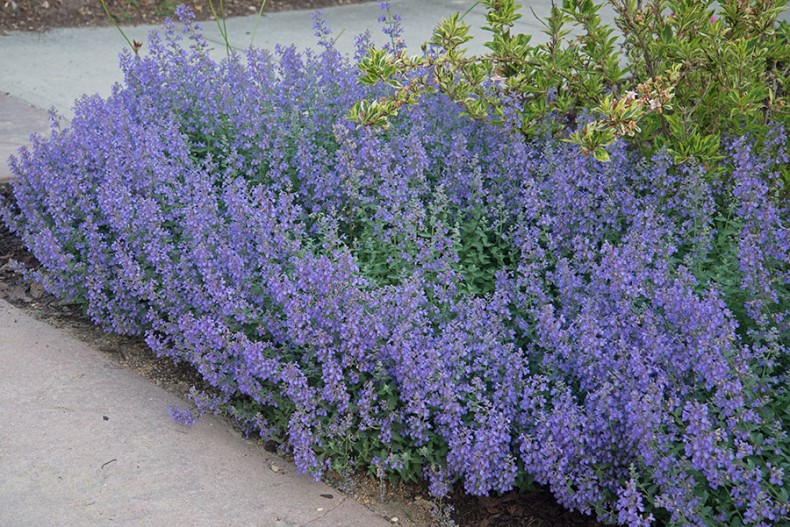Count on Catmint for Reliable, Showy Flowers
Plus Garden To-Do’s for April
By L.A. Jackson“Junior Walker” Catmint
Catnip (Nepeta cataria) is a plant well-known to kitty owners who love to see their feline friends get goofy. But a close cousin, catmint (Nepeta faassenii), packs a visual pop that can have gardeners purring with delight.
Unlike catnip, which shows modest flower displays and tends to be weedy, catmint is more manageable — typical selections are sterile hybrids — and has the potential to be a reliable go-to plant for landscape eye candy.
Like catnip, catmint is edible. Culinary herbalists typically use it in sauces, teas, salads and soups. Unlike catnip, catmint does not usually provide an intense buzz for kitties.
An herbaceous perennial, catmint lights up the spring growing season with a blooming bang, covering itself with masses of small, lavender-bluish blossoms. Flowering at a lesser pace will continue until fall, although it might sputter in the high heat of summer. Nonetheless, when planted in concentrated groupings, catmint will dependably stroke swaths of pleasing color through a garden bed during most of the growing season.
Easily winter hardy in all Carolina gardens, catmint is a deer-resistant, low-maintenance, lightly fragrant plant that, once established, can survive drought conditions, creating possibilities for its use in xeriscaping projects and rock gardens. It could suffer in heavy clay or areas that don’t drain well, so generously amending such inhospitable growing grounds with compost or commercial soil conditioners is a good idea. Note that too much nitrogen fertilizer can cause branches to stretch and flop. While catmint prefers full sun, selecting a site that settles into light shade during the heat of the day will help keep its flower displays looking fresher.
For years, the cultivar “Six Hills Giant” has been the catmint’s meow for gardeners, but, as its name implies, it is a biggie, growing up to 3 feet tall and about as wide. So give it room. “Walker’s Low,” the Perennial Plant Association’s Perennial of the Year in 2007, has a similar sizeable display. Looking for less? Consider “Junior Walker,” which only tops out at around 16 inches tall and 30 inches wide.
Like catnip, catmint is edible. Culinary herbalists typically use it in sauces, teas, salads and soups. Unlike catnip, catmint does not usually provide an intense buzz for kitties. For intense buzz of an acoustic nature, however, keep in mind catmint flowers are irresistible to hummingbirds and bees. Ditto for butterflies.
Catmint should not be hard to find locally this spring, especially at garden centers with decent herb plant sections, but a sure Plan B is to e-shop for this purr-fect perennial online.
Garden To-Do’s for April
-
The cast iron plant (Aspidistra sp.) is as advertised — a tough evergreen perennial that can provide constant verdant color to dry, shady areas, even in the winter. However, arid, cold winds can beat up leaves to the point they become ragtag with streaks of brown splotches. These damaged leaves can be pruned out now to perk up this handsome plant. In fact, if the entire clump of your established cast iron plant looks worn, go ahead and clip all the old leaves down to about 2-inch nubs. Such a severe pruning will encourage new foliage to come roaring back by midsummer.
-
Green thumb itching to start the summer veggie garden? The middle to end of this month is a good time to give it a scratch with plantings of such heat-loving edibles as peppers, tomatoes, green beans, cucumbers and squash.
-
Early summer vegetables will jump off to faster starts if they aren’t heavily mulched at planting time. This will give the strengthening spring sun time to warm the soil around young plants to encourage stronger root growth. Then, by late May, when heat of the new summer really starts to be felt, add a serious layer of insulating mulch for the sizzle to come.
-
Dahlias can be set in the garden as soon as the threat of frost has passed. For taller cultivars, add a support stake in each planting hole to avoid damaging the root system or (especially) tubers later.
-
More April gardening tips
-
Share this story:







